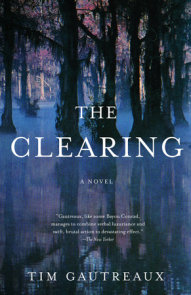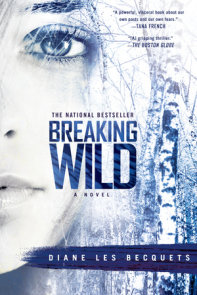READERS GUIDE
“An absorbing, often dreamlike story.” –The New York TimesIn her novel, In a Dark Wood, Amanda Craig takes the reader on one man’s manic ride through the hidden depths of his family history into his own disturbed mind. We hope the following introduction, discussion questions, suggestions for further reading, and author biography enhance your group’s reading of this mesmerizing and inventive exploration of the intersection between manic depression, reality, imagination, and creative self-expression.
Introduction
London native Benedick Hunter is a recently divorced, out-of-work actor and the ambivalent father of two young children, who is battling loneliness and depression. While going through the motions of packing his possessions to move from his house, Benedick finds a book of fairy tales by his late mother entitled North to Nowhere. Upon opening the book, he embarks upon a journey discovering his mother’s concealed past–her seemingly unhappy marriage, her secret family in America, her success as a children’s illustrator and author, and, ultimately, her unexplained suicide when Benedick was just a boy. Intrigued by the mystical and dark stories in his mother’s work and the familiar faces in her illustrations, Benedick discovers piece by piece his mother’s troubled life, traversing the turbulent waters of his own mind in the process. His research leads him across the Atlantic to rural America outside Charleston, South Carolina, where his mother’s family still lives. The bizarre and grim truth that Benedick unearths there finally completes the puzzle about his mother’s past and leads to the diagnosis of his own mental illness.Running the gamut from cryptic to familiar, horrifying to comic, disturbing to moving, the story line of In a Dark Wood swings as dramatically as the moods of its protagonist. Craig keeps the reader guessing while she escalates the frenzied rise and fall of Benedick’s mania, providing relief to the reader in the form of answers, and to Benedick in the form of mood-equalizing lithium.
Questions and Topics for Discussion
1. Contemplating his divorce, Benedick describes his state of mind: “What frightened me most was, I could no longer believe in my own life as a story. Everyone needs a story, a part to play in order to avoid the realization that life is without significance. How else do any of us survive? It’s what makes life bearable, even interesting. When it becomes neither, people say you’ve lost the plot. Or just lost it” [p. 19]. At the end of the novel, when Benedick finds acting work, he concludes: “It was this, I think, as much as the lithium, that made me better. It meant that I hadn’t been written out of the story of my life. People say that life has no story, that to believe it does is a symptom of madness, and I had thought this, too. But I knew I couldn’t go on living without some version of the truth. Every version has its blessing and it curse” [p. 301]. Is Benedick’s statement that “everyone needs a story” just the artist speaking, or is he expressing a universal truth? What is the story of Benedick’s life? What is his version of the truth and how does it evolve?
2. How does each fairy tale that Benedick reads reveal more and more about Laura’s life and state of mind? What is the significance of the order of the tales in North of Nowhere as read by Benedick throughout the novel? Why might Craig have chosen to name her novel for Laura’s first book, In a Dark Wood, when it is actually Laura’s fairy tales in North of Nowhere that structure the plot of the novel?
3. Ruth tells Benedick: “If you read fairy tales carefully, you’ll notice they are mostly about people who aren’t heroes. They don’t have special powers, or gifts. Often they are despised as stupid. They are bullied, beaten up, robbed, starved. But they find they are stronger than their misfortunes” [p. 25]. Is Ruth correct? If so, can “The Wild Wood” [pp. 200—207] be accurately characterized as a “fairy tale” or is it something else? How might the genre of fairy tales be defined or explained? How do fairy tales compare to other literary genres? Is it correct to assume that fairy tales are children’s literature, and, if so, why?
4. How does Benedick’s illness manifest itself physically–especially after he arrives in America? If his divorce can be understood as the trigger for his depression, what might have triggered his high?
5. What accounts for the fluctuations in Benedick’s personality, such as when he gives his son and daughter each a smack [p. 57] and when he buys them fourteen pairs of shoes [pp. 253-254]? Are they significant in any way or are they a normal reaction to the circumstances in his life?
6. Benedick says of his divorce: “And this is the most hideous thing about somebody falling out of love with you. When someone loves you, you show your best self to them, to the world. When you lost that love, you lose your best self, and are shown instead how loathsome and contemptible you truly are. To be seen without love by someone who once loved you is to be made lower than anyone can endure” [p. 59]. And later, Benedick lucidly realizes: “I thought of the people I had questioned when trying to find out about my mother. I had been so ready to dislike and condemn them, but it was really myself I had been disliking and condemning. You’re either unbearable to other people or you’re unbearable to yourself, the psychiatrist had said. What if I were both?” [p. 295] Are Benedick’s two statements reconcilable? Is Benedick’s earlier statement symptomatic of a man recently divorced or of a manic depressive or both? Can Benedick’s feelings and behavior towards other people be attributed to his mental illness or his personality? Are the two so intertwined that it is impossible to separate them?
7. Benedick offers Flora an explanation of “mad”: “It’s when you see or feel things differently from other people” [p. 128]. Does In a Dark Wood confirm or refute this definition? How else might one define madness?
8. The following exchange between Benedick, Ruth, and Cosmo is one example of how the English personality and temperament is compared and contrasted with the American personality and temperament:
“Is that true, that you can become anything? Cosmo asked.
“Yes,” said Ruth firmly. “That’s what American’s believe.”
“Do English people believe that?”
I [Benedick] cleared my throat. “No, not really.”
“What do we believe in?”
“In irony,” I said. (p. 129)
In what other ways are English and American psyches and temperaments compared and contrasted in the novel?
9. Benedick says: “I grew up in a generation which had no idea that women were going to be our equals. You were just supposed to keep going no matter what. But now there’s no place for us. We’re a biological dead end. It’s stupid to even keep on living” [p. 24]. Does this accurately describe the current state of affairs with regard to equality between the sexes? What was the gender balance between Benedick and Georgie, and how did it affect their relationship? From what Benedick is able to piece together, how did gender equality or lack thereof affect Laura’s life and career?
10. Benedick comments: “ It was strange, I thought, the way all the women I had interviewed about my mother spent at least as much time describing their own lives as hers” [p. 182]. What do this and other comments in the novel reveal about the differences between males and females? Is the illness manifested differently in Benedick than Laura because of their different genders?
11. How could Benedick’s relationship with his children be characterized? Is he a typical father? Are his frustrations and celebrations normal? Are they indicative of his illness, and, if so, how?
12. How accurately does Craig, a female author, give her male protagonist an authentic male voice? How does her choice to narrate the novel in the first person affect the reader’s understanding of Benedick? Of his mental illness?
13. What does acting mean to Benedick? How is it different than another occupation? How might it take on a different meaning for him in light of his mental condition?
14. What is the implication of Jane Holly’s statement to Benedick that “artists are nearly always called [mad]. Some are genuinely so. What they do isn’t the product of being nice, or even particularly sane. They’re running over the Bridge of One Hair, like Lolly” [p. 185]? How does the artistic temperament differ from that of non-artists?
15. How is the creative process of acting compared to that of writing in the novel?




















